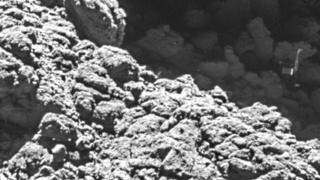 Image copyright ESA / Rosetta / MPS for OSIRIS Team
Image copyright ESA / Rosetta / MPS for OSIRIS Team
Hello, old friend!
The Philae robot, which landed in 2014 in the 67P / Churyumov comet Gerasimenko, was identified in one of the images that sent the Rosetta probe orbiting the space rock.
Officials of the European space Agency (ESA, its acronym in English) said that there had doubt that the sighting of Philae was “as clear as day” .
the robot was released in the comet by the Rosetta probe in 2014 , where could transmit information for 60 hours before its battery was finished.
Although he managed to send back to Earth images and data from its location, the site of his final landing was a mystery.
the images of the high resolution camera Osiris , the Rosetta probe, were discharged on Earth on Sunday night.
Philae appears on an outcropping of rocks that hinder visibility, but are unmistakable legs and part of the robot of a meter wide body.
The Rosetta probe had previously examined This area, known as Abydos, but without any positive results.
There were sightings probable, but none were convincing.
the difference today is a closer view and a change in the seasons in the comet, meaning that the place where the robot is was now brighter.
the discovery comes just weeks before drivers Rosetta try to make a landing on the comet to finish research 67P.
Although there is no hope of turning the robot, knowing their landing site will help scientists better understand the data sent during three days of operation in 2014.
“it was very important to find Philae before the end of the mission, to understand the context of their scientific in situ measurements,” professor Mark McCaughrean, scientific Director of the ESA, the BBC said.
“it was so important as giving emotional closure for the millions of people who have been following Philae and Rosetta through the trials and tribulations of his exploration of this remarkable remnant of the birth of our system Solar “.
30 September will be when Rosetta will fall into the comet to complete its mission.
The nickname 67P / Churyumov-Gerasimenko is “ duck ” in form
Here are some fun facts comet:
- a complete rotation of the body takes a little over 12.4 hours.
- the axis of rotation is in the region” neck “.
- His biggest lobe, or “body”, is approximately 4.1 × 3.3 × 1.8 km.
- The smallest lobe, or” head “, is about 2.6 x 2.3 x 1.8 km.
- gravity measurements give a mass of 10 million tons
- a mapping estimates that the volume is equivalent to 21.4 cubic kilometers.
No comments:
Post a Comment